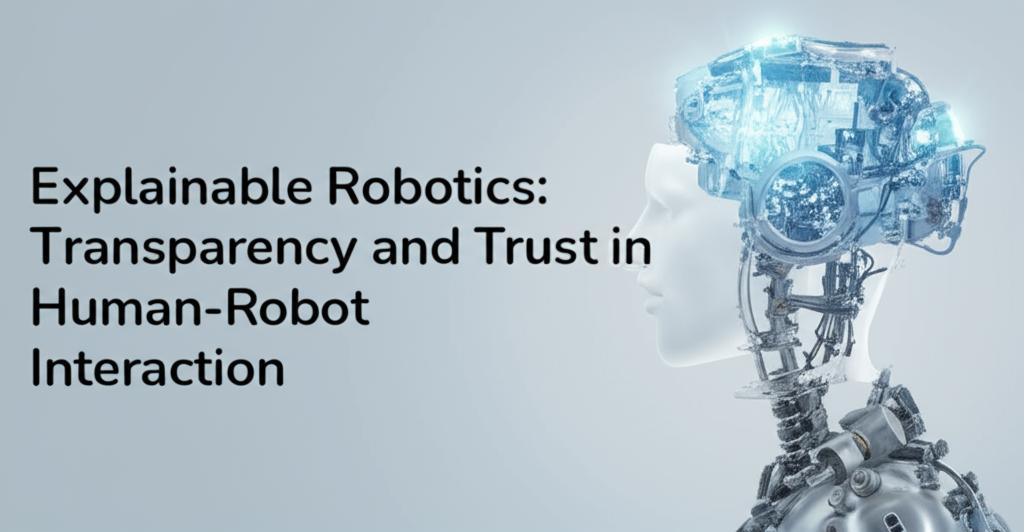As robots become increasingly integrated into our lives, from manufacturing floors to our homes and healthcare facilities, the ability for humans to understand and trust these complex systems is paramount. Explainable Robotics, a field stemming from Explainable Artificial Intelligence (XAI), focuses on making robotic actions and decision-making processes transparent and comprehensible to human users. This transparency is crucial for fostering trust, ensuring safety, and enabling effective human-robot collaboration.
Why Explainability Matters in RoboticsTraditionally, many AI systems, including those powering robots, have operated as "black boxes." Their internal workings and the reasoning behind their decisions are often opaque, even to their developers. This lack of insight can be a significant barrier to trust and acceptance, especially when robots are performing critical tasks or working in close proximity to humans. If a robot makes an unexpected move or an error, understanding why can be essential for safety, debugging, and improving future performance.
Explainable AI in robotics aims to address this by equipping robots with the ability to articulate the "why" behind their actions in a way that humans can understand. This is not just a desirable feature but a necessity as autonomous systems take on more complex roles in society. Research highlights a growing demand for AI systems to be fair, transparent, and accountable, particularly in scenarios involving close human-robot interaction. People are more likely to distrust robots if they can't understand their actions, perceiving unexplained behaviors as erratic or unsettling.
Key Strategies for Achieving Explainable RoboticsResearchers and developers are employing various strategies to make robotic decision-making more transparent:
- Visualization Techniques: These methods aim to make the complex internal states of a robot, such as the activations within a neural network, interpretable through visual representations.
- Natural Language Generation: Robots can be programmed to provide explanations for their actions in plain language, making it easier for non-experts to understand their reasoning. This can involve verbalizing their thought processes or intentions, similar to how a human colleague might explain their actions.
- Symbolic Reasoning: Integrating machine learning with symbolic reasoning methods can create hybrid models that are both powerful and interpretable. Symbolic AI uses logic and structured representations, which can be more readily understood than purely data-driven approaches.
- Emotional Expressions and Inner Speech: Designing robots to exhibit emotional cues, similar to humans, can make their learning processes and decision-making more relatable and predictable. Enabling robots to use "inner speech" – to articulate their internal states and plans – offers deeper insight into their actions.
- Log Analysis and Vision-Language Models (VLMs): Analyzing robot operation logs, especially when combined with visual input through VLMs, can generate more accurate and context-aware explanations. VLMs allow the system to interpret textual logs alongside images captured by the robot, leading to a richer understanding of the robot's behavior and its environment.
Despite the progress, several challenges remain in making robotics truly explainable:
- The Accuracy-Interpretability Trade-off: Often, the most accurate AI models are the most complex and, therefore, the hardest to explain. Simpler, more interpretable models might sacrifice some performance. Finding the right balance is critical, especially in applications where both high performance and transparency are essential, such as autonomous vehicles or medical robotics.
- Technical Implementation: Developing systems that can generate meaningful explanations in real-time without significantly impacting the robot's primary tasks is a complex engineering challenge. Explanations need to be timely and relevant to the user's current context.
- Defining "Good" Explanations: What constitutes a good explanation can vary depending on the user, their expertise, and the specific situation. Explanations need to be tailored to the audience and the purpose of the interaction.
- Bias in Explanations: Just as AI models can inherit biases from their training data, the explanations they generate can also reflect these biases. Ensuring fairness and objectivity in explanations is crucial.
- Ensuring Safety and Reliability: Without understanding how a robot reached a conclusion, it's difficult to determine if it's reliable, which is a significant concern for safety-critical applications.
The field of explainable robotics is rapidly evolving. Future trends point towards:
- Interdisciplinary Approaches: Collaboration between computer scientists, cognitive psychologists, human-computer interaction (HCI) experts, and domain specialists is becoming increasingly important to create more intuitive and effective explanation mechanisms.
- Advanced Visualization and Communication: Expect more sophisticated visual interfaces and natural language capabilities to make robot decision-making processes even more accessible.
- Personalized Explanations: AI systems will likely become better at adapting their explanations to individual users' needs and levels of understanding.
- Focus on Trust Calibration: The goal is not for users to blindly trust AI, but to have a well-calibrated sense of when and how much to trust the system, based on clear explanations of its capabilities and limitations.
- Integration with Ethical Frameworks and Regulations: As AI becomes more pervasive, regulations like the EU AI Act will increasingly require transparency and explainability in AI systems, making XAI a mandatory component in many industries.
As we move towards a future where humans and robots work and live side-by-side, the ability of these autonomous systems to explain themselves will be fundamental. By transforming robots from inscrutable machines into communicative and understandable partners, explainable robotics paves the way for a more harmonious, productive, and trusting coexistence. The ongoing research and development in this area are critical steps toward unlocking the full potential of robotics to benefit society safely and effectively.

